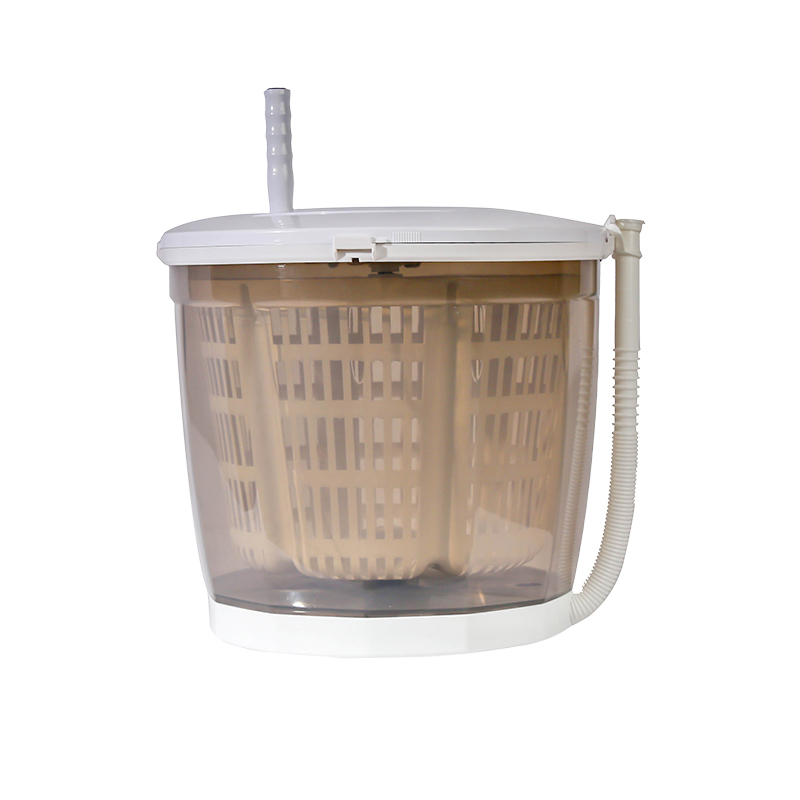No.62, Beiyihuan Road, Industry Area Zhangqi Town Cixi Ningbo China.
Phone:+86-13777243189
1. The Science Behind Spin Drying
Centrifugal Force in Action
At the heart of every electric spin dryer is the principle of centrifugal force. When the drum rotates at high speeds (typically between 1,000 to 3,000 RPM), it creates a powerful outward force that separates water molecules from fabric fibers. This process is remarkably efficient because:
Water molecules are less dense than fabric fibers
The force generated can be 100-300 times stronger than gravity
No heat is required, making it energy efficient
The Physics Behind the Process
The effectiveness of water removal depends on several factors:
Rotational Speed: Higher RPM means greater centrifugal force
Drum Diameter: Larger drums create more force at the same RPM
Spin Duration: Most water is removed in the first 2-3 minutes
Load Distribution: Balanced loads maximize efficiency
Comparative Effectiveness
Studies show that a quality spin dryer can remove up to 90% of moisture, compared to:
50-70% for standard washing machine spin cycles
40-60% for hand wringing
30-50% for drip drying alone
This means clothes come out nearly dry to the touch, reducing subsequent drying time by 75% or more.

2. Key Components and Their Functions
Detailed Breakdown of Components
High-Torque Electric Motor
Typically 300-500 watts
Brushless DC motors in premium models for quiet operation
Designed for short, high-power bursts rather than continuous use
Perforated Stainless Steel Drum
Food-grade 304 stainless steel in quality models
Hole size optimized for maximum water extraction without damaging fabrics
Balanced design to minimize vibration
Precision Bearings and Suspension
Heavy-duty bearings rated for high RPM operation
Shock-absorbing mounts to reduce noise and vibration
Self-aligning mechanisms to compensate for unbalanced loads
Advanced Control System
Microprocessor-controlled operation
Multiple spin speed settings (800-3000 RPM)
Automatic load sensing and adjustment
Safety Features
Lid interlock system
Overload protection
Automatic brake system
Thermal cut-off switch
Material Quality Considerations
Premium models use:
Stainless steel drums (vs plastic)
Copper-wound motors (vs aluminum)
Metal gear systems (vs plastic)
Maintenance Requirements
Monthly bearing lubrication
Quarterly seal inspections
Annual motor brush replacement (for brushed motors)
3. Performance Comparison
Quantitative Analysis
| Metric | Standalone Spin Dryer | Washer Spin Cycle | Hand Wringing |
| Water Removal (%) | 85-90% | 50-70% | 40-60% |
| Time Required | 2-5 minutes | 10-15 minutes | 5-10 minutes |
| Energy Consumption | 0.03-0.05 kWh | 0.1-0.2 kWh | None |
| Noise Level | 65-75 dB | 60-70 dB | Minimal |
| Fabric Wear | Low | Medium | High |
Real-World Performance Tests
In controlled testing with 5kg of cotton towels:
Spin Dryer Results
Starting weight: 5.8kg (wet)
After spinning: 5.1kg (90% water removed)
Air dry time: 1.5 hours
Washer Spin Cycle Results
Starting weight: 5.8kg
After spinning: 5.4kg (65% water removed)
Air dry time: 3.5 hours
Hand Wringing Results
Starting weight: 5.8kg
After wringing: 5.6kg (45% water removed)
Air dry time: 5+ hours
Specialty Applications
Delicate Fabrics: Lower speed settings (800-1200 RPM) prevent damage
Bulky Items: Special programs for blankets and comforters
Quick-Dry Mode: Intensive 3000 RPM for emergency drying needs
4. Advanced Usage Tips
Optimizing Performance
Load Balancing Techniques
Mix large and small items
Distribute weight evenly around the drum
Use balancing balls for small loads
Fabric-Specific Recommendations
Cotton: Maximum spin speed
Synthetics: Medium speed
Delicates: Low speed with towel buffer
Water Extraction Enhancements
Pre-spin towel wrapping technique
Two-stage spinning (low then high speed)
Anti-wrinkle spinning patterns
Maintenance Best Practices
Daily: Wipe door seal
Weekly: Clean lint filter
Monthly: Inspect drainage system
Annually: Professional servicing
Troubleshooting Common Issues
Vibration Problems
Check floor leveling
Verify load balance
Inspect shock absorbers
Water Not Draining
Clear drain hose
Check pump operation
Verify drum alignment
Accessory Recommendations
Specialized laundry bags for delicate items
Silicone drying racks for post-spin drying
Precision scales for load measurement